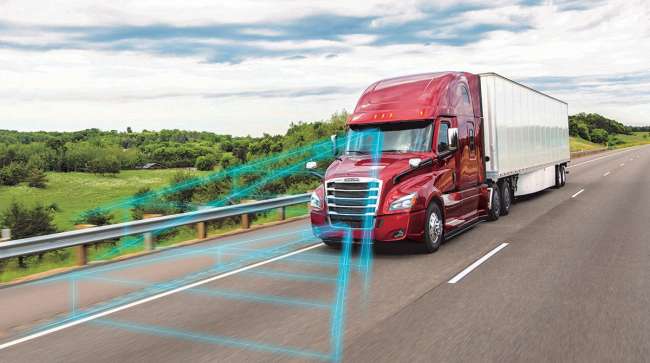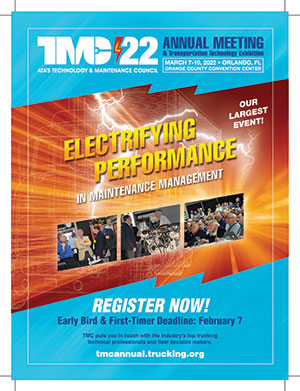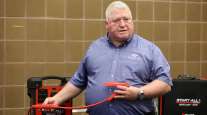TMC Eyes Automated Driving Systems With New Recommended Practices

[Find the latest in equipment & maintenance: Explore this quarter's issue of Calibrate]
As the weather has turned frosty and with hockey season well underway, TMC has “turned a hat trick” in pursuing three goals for its development of prospective Recommended Practices (RPs) covering automated vehicles.
In fact, capitalizing on the energy released at the in-person 2021 Fall Meeting, in Cleveland, TMC will be balloting 30 new and revised RPs over the winter (enough for 10 hockey hat tricks).
TMC’s partnership with the Federal Motor Carrier Safety Administration (FMCSA) and other industry groups seeks greater deployment and effective utilization of Advanced Driver Assistance System (ADAS) technologies through the Tech-Celerate Now Program, with these RP developments playing an important supporting role.
More Q1 Calibrate
►Preventive Maintenance Keeps Mobile Air Conditioners Humming
►Trailer GHG Ruling Muted by California Rules, Industry's Direction
►Five Questions: Kerry Stritt, Southeastern Freight Lines
►Freeze: New Year, Used Trucks
►Baxter: Mack, Military Team Up on Combat-Ready Dump Truck
Explore the Issue!
Goal No. 1: ADAS Nomenclature
Automation is gaining momentum in the commercial vehicle spaces, from the latest generation of ADAS gaining an ever-greater share of fleet specifications for new vehicles to the increasing on-road experience with Automated Driving Systems (ADS). These new technologies bring a steep learning curve for both fleet executives and technicians who must keep these systems running in peak condition, and the drivers who operate high-tech medium- and heavy-duty trucks.
In addition to driver acceptance, one important aspect of fleet expectations for ADAS and ADS across all levels of automation (SAE, international standard J3016) is a common understanding of the terminology describing the various system components. With ADAS/ADS suppliers and OEMs employing proprietary terms for naming these automation elements, it’s to industry’s benefit to use common terminology for design, functionality and performance. This knowledge base will provide clarity and meaning to the transition from the “basic ADAS” of automation Level 1, through the multiple component warning and assistance of Level 2, to the higher functioning of active vehicle control in Level 3, to full automated vehicle control in Levels 4 and 5 (with or without a human operator).
A joint Task Force of TMC’s S.5 Fleet Maintenance Management and S.18 Automated and Electric Vehicles Study Groups recently recommended a new Recommended Practice, RP 547(T), Guidelines for Advanced Driver Assistance System (ADAS) Nomenclature, which is currently being balloted to the council’s membership. It is designed to help fleet personnel identify and cross-reference terminology associated with various technologies and their functions. The objective is to harmonize ADAS terms for vehicle specifications and fleet maintenance, thereby encouraging standardization of ADAS terms throughout industry wherever feasible.

Braswell
The proposed RP seeks to provide a glossary of terms for various ADAS technologies. The information is presented as a table, listing system names, acronyms, their definitions, as well as alternative names and acronyms. In order to identify the most common/preferred term, the definition is shown next to that term, with less common terms showing a cross-reference to the preferred terminology.
One of the obstacles in greater acceptance of ADAS among truck drivers is their expectations regarding the performance of ADAS components. TMC believes this proposed RP will help drivers use the proper terminology when communicating to one another and to maintenance technicians. For example, the driver’s expectations for vehicle performance are vastly different for a single truck equipped with Blind Spot Assist (BSA) — which will initiate an active steering response if the driver does not react to a blind spot conflict— to another that only has a Blind Spot Monitoring (BSM) feature (the change of one letter in an acronym can make all the difference on the highway).
Goal No. 2: Enhanced Vehicle Inspection
MC’s S.18 Study Group is also taking on the challenge of what pre-trip inspections should entail the quickly evolving class of commercial vehicles that will be equipped and eventually actually operated by Automated Driving Systems. In its recently released Position Paper 2021-1, Recommendations Regarding Inspection and Enforcement for Automated Commercial Vehicles, TMC recommends that the industry consider the Commercial Vehicle Safety Alliance (CVSA) Option 7 framework as a model for enhanced pre-trip inspections model for Automated Commercial Vehicles (ACMVs). TMC believes this approach, which seeks to eliminate en-route stops for roadside inspections, represents the most logical framework to assist commercial fleets in addressing the unique inspection and enforcement needs of SAE J3016 Level 4 and Level 5 Automated Commercial Motor Vehicles (ACMVs).

Legler
An enhanced pre-trip inspection process would include an operational function status check of all ADS components, a “fault-free” health check of the ADS control system and an operational safety check of the overall commercial vehicle/combination. The results of the inspection, vehicle identification and weight, and continuing operational and health status of the ADS system, would be kept in a standard messaging format, ready to be communicated to CMV enforcement as necessary. TMC supports industry development of an in-motion inspection confirmation process. A vehicle would report a “green” ADS health status only if the CMV is safe to complete the current ADS-driven trip without any in-vehicle human assistance, and the ADS, comprising both hardware and software, is functioning within its acceptable operating specifications for ADS operation (including its Operational Design Domain). In addition, an ACMV would report a “green” truck operational status only if the truck’s tractor and trailer passed the enhanced pre-trip inspection.
ADS developers are working closely with OEMs and suppliers in incorporating sensors, telematics and analytics in a holistic approach to vehicle specification that will enable the self-diagnostic capabilities necessary to meet the objectives of the Option 7 framework. ACMVs can take advantage of state-of-the-art sensing and control systems such as smart hubs, tire pressure monitoring and automatic inflation systems, advanced vehicle stability control systems, brake pad wear, engine and transmission control and diagnostics, vehicle lighting status and the like. Both TMC and SAE International have recognized that trailers, because of their long life and challenges involving retrofitting, pose the most significant inhibitor to the objectives of the Option 7 model. Both organizations are working with their respective domains to overcome these challenges.
TMC’s Task Force will continue discussions will all stakeholders, including fleets, OEMs, ADS system developers, CVSA and federal agency experts in order to address inhibiting factors identified in this paper so as to operationalize an inspection/enforcement model, and to delineate the technical and maintenance requirements for various ADS elements.
Goal No. 3: Technician Training for ADAS
TMC’s S.5 Study Group has also charged a task force with the objective of developing essential knowledge and skills that technicians must possess to inspect, maintain, troubleshoot and correct ADAS systems. Acknowledging that ADAS systems are levels of magnitude higher in technical and logical sophistication from their ADAS progenitor components, the capabilities that technicians acquire in addressing ADAS technologies will lay the foundation upon which they are prepared to meet the maintenance challenges involved with the higher levels of driving automation.
Want more news? Listen to today's daily briefing above or go here for more info
The S.5 Task Force is well underway in drafting a proposal for an ADAS technician training framework. At its current level of discussion, the task force has determined that ADAS can be affected by anything that can change sensor detection and/or location, cab ride height, etc. Therefore, technicians must take a “whole truck approach” when servicing ADAS-equipped vehicles. For example, all ADAS repair procedures are based off the assumption that the vehicle being serviced has a properly functioning antilock braking system (ABS).
TMC has identified four areas that it is considering of importance for technician training: onboarding new ADAS equipment, performing preventive maintenance (PM), diagnosing driver complaints and performing collision repair procedures. Critical for successful maintenance is the technician’s understanding of the specific system being: the location of all ADAS components, sensors, controllers, etc., the correct diagnostic equipment and its use with that particular system, and being able to communicate effectively with drivers to translate the complaint into a thorough checking to determine and correct the cause.

In the event of damage to the vehicle, such as in a collision, TMC is developing a “triage” process for technicians to follow in assuring a deeper look into physical damages that may affect ADAS or other systems that can cause ADAS to be degraded or disabled. Technicians need to understand that a visual inspection will not always locate all safety systems and sensors but that researching the sophistication of the system may require additional probing with diagnostic software.
TMC and its members are working to keep pace with the rapid technical advances in vehicle automation technologies to address the current maintenance realities of ADAS and to set the stage for safe and effective deployment of even more sophisticated safety assistance systems in coming years. As always, TMC will move ahead on these and more than 100 other RP development projects at the council’s upcoming TMC 2022 Annual Meeting & Transportation Technology Exhibition at the Orange County Convention Center in Orlando, March 7-10. We look forward to seeing you there.





